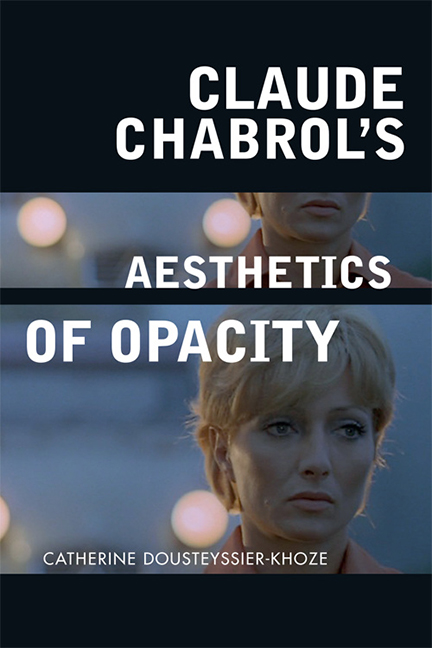Book contents
- Frontmatter
- Contents
- List of Figures
- Acknowledgements
- Dedication
- Introduction
- 1 Contexts and Influences
- 2 Chabrol and Genres
- 3 The Human Beast
- 4 Family Secrets
- 5 Chabrolean Spaces as Heterotopias of Crisis
- 6 Through the Looking Glass: Chabrol’s Mirrors and the ‘Crystal-image’
- Conclusion: Towards an Aesthetics of Visual Opacity
- Filmography
- Bibliography
- Index
5 - Chabrolean Spaces as Heterotopias of Crisis
Published online by Cambridge University Press: 10 November 2020
- Frontmatter
- Contents
- List of Figures
- Acknowledgements
- Dedication
- Introduction
- 1 Contexts and Influences
- 2 Chabrol and Genres
- 3 The Human Beast
- 4 Family Secrets
- 5 Chabrolean Spaces as Heterotopias of Crisis
- 6 Through the Looking Glass: Chabrol’s Mirrors and the ‘Crystal-image’
- Conclusion: Towards an Aesthetics of Visual Opacity
- Filmography
- Bibliography
- Index
Summary
Far from functioning on a purely realistic mode, Chabrolean spaces are key loci in which inner conflicts and tensions often acquire a symbolic dimension. Houses or functional buildings (schools, hospitals) become places in which generic battles take place and the real and the virtual come to a head. The respectable bourgeois house can seamlessly turn into a doll-house or a stage (Que la bête meure; Juste avant la nuit), a Gothic mansion (La Demoiselle d’honneur), a crime scene (Violette Nozière; La Fleur du mal; Poulet au vinaigre), a timeless temple (the hospital in Le Boucher) or a cave (La Demoiselle d’honneur). Foucault's concept of heterotopia, as formulated in ‘Des espaces autres’/‘Of Other Spaces’, will be particularly useful to approach these highly unstable Chabrolean topographies. The term, coined in 1966 within his preface to Les Mots et les choses, was fully developed a year later, in March 1967, when Foucault gave a presentation at the Cercle d’études architecturales. Foucault was said to have been reluctant to publish the lecture at the time and the transcript of ‘Des espaces autres’ only appeared in 1984, in the architectural journal Architecture, Mouvement, Continuité. Although it originates from and has specific applications for the Social Sciences, the concept has had a significant impact on the Humanities in general and is of particular relevance to Visual and Film Studies in that it helps rethink the various representations of space(s).
According to Foucault, ‘the heterotopia is capable of juxtaposing in a single real place several spaces, several sites that are in themselves incompatible’; its role ‘is to create a space of illusion that exposes every real space, all the sites inside of which human life is partitioned, as still more illusory’. How can this definition of a ‘space of illusion’ be applied to cinema that is, by itself, a kind of heterotopia that creates multiple illusory worlds on to a flat screen? There is indeed right from the beginning a mise en abyme effect and the notion of heterotopia within a cinematic context should pay particular attention to what is meant exactly by ‘reality’ and ‘illusion’.
- Type
- Chapter
- Information
- Claude Chabrol's Aesthetics of Opacity , pp. 118 - 141Publisher: Edinburgh University PressPrint publication year: 2017



